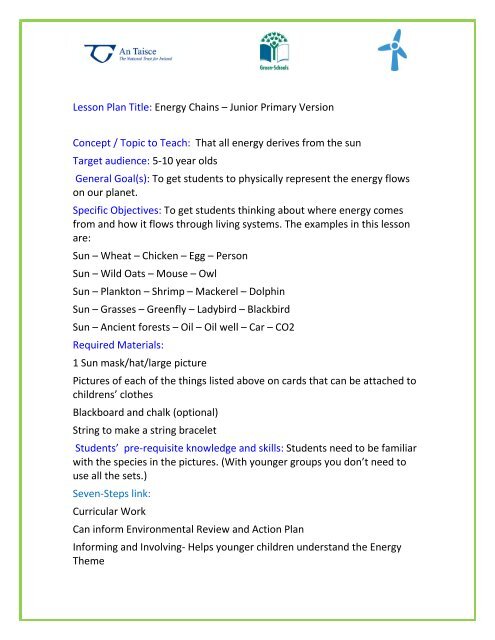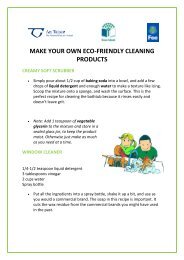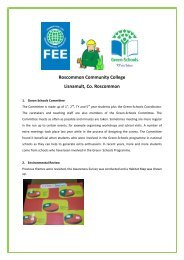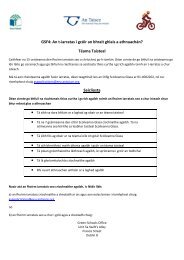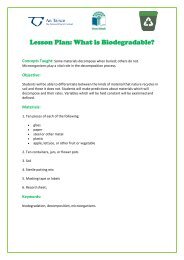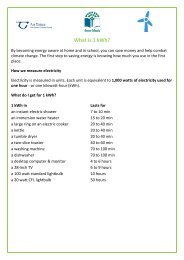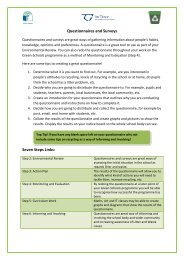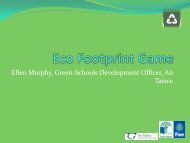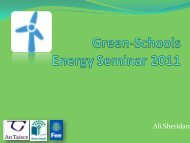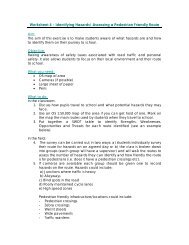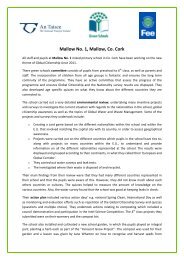Energy Chain Lesson Plan - Green Schools Ireland
Energy Chain Lesson Plan - Green Schools Ireland
Energy Chain Lesson Plan - Green Schools Ireland
Create successful ePaper yourself
Turn your PDF publications into a flip-book with our unique Google optimized e-Paper software.
<strong>Lesson</strong> <strong>Plan</strong> Title: <strong>Energy</strong> <strong>Chain</strong>s – Junior Primary VersionConcept / Topic to Teach: That all energy derives from the sunTarget audience: 5-10 year oldsGeneral Goal(s): To get students to physically represent the energy flowson our planet.Specific Objectives: To get students thinking about where energy comesfrom and how it flows through living systems. The examples in this lessonare:Sun – Wheat – Chicken – Egg – PersonSun – Wild Oats – Mouse – OwlSun – <strong>Plan</strong>kton – Shrimp – Mackerel – DolphinSun – Grasses – <strong>Green</strong>fly – Ladybird – BlackbirdSun – Ancient forests – Oil – Oil well – Car – CO2Required Materials:1 Sun mask/hat/large picturePictures of each of the things listed above on cards that can be attached tochildrens’ clothesBlackboard and chalk (optional)String to make a string braceletStudents’ pre-requisite knowledge and skills: Students need to be familiarwith the species in the pictures. (With younger groups you don’t need touse all the sets.)Seven-Steps link:Curricular WorkCan inform Environmental Review and Action <strong>Plan</strong>Informing and Involving- Helps younger children understand the <strong>Energy</strong>Theme
Anticipatory Set (Lead-In): Ask students to wave their hands/do a dance etcAsk them “Where did you get the energy to do that? “ (from food)What did you eat? (e.g. porridge) “Where did the oats get the energyfrom? “ (the Sun) Do a few examples like this, linking energy back to thesun.Discuss the fact that only plants can get their energy directly from the sunanimalshave to eat plants or other animals that have eaten plants.Step-By-Step Procedures:• Get one child to be the sun• This child hangs the sun picture around his/her neck and stands inthe middle of a clear space in the room. Give this child the stringbracelet to put around his/her wrist• Give each child a picture of one of the organisms from the first fourgroups. (see list above)• Ask the children “Who has a picture of something that gets energydirectly from the sun?” Give each of those a piece of string and theygo and stand with the “sun” and they hold onto one of the string’s onthe sun’s bracelet and stretch it out. They hold their own string in theother hand.• Then ask if anyone has a picture of something that gets energy fromone of those things (i.e., eats it) Give them a piece of string and theygo and stand by their plant and stretch the plant’s piece of stringbetween them. Continue on in this way. You don’t need to give thelast link in the chain any string- they just hold the other end of theprevious child’s string
• Ask the students what happens to the energy as it goes through thechain (organisms use it to move, to keep warm, to grow, toreproduce etc ) What happens when the organisms die? Where doesthe energy go?• Now give out the last set of pictures (Forest, Oil barrel, Oil Derrick,Car)• You may need to explain how oil and other fossil fuels were formedfromthe fossil remains of plants and animals that lived long long ago(75 million years ago and 150 million years ago- these were the twoperiods when most of our fossil fuels were formed) Ask “”Where didthose ancients trees get their energy?” Explain that the energy wascompressed by earthquakes, soil building up on top, heat andtectonic plate movements. The amount of fossil energy we use everyyear took about 450 years worth of sunlight to create.• Ask the children how we get the energy out again (by burning thefuel). What happens to a lot of the energy (it is released as heat).What else is released by burning fossil fuels? (CO2)• Get the children to make a chain with the oil pictures in the sameway. Ask “What is the difference between the oil chain and the otherenergy chains? “ (the oil one uses the sun’s energy stored overmillions of years, the others all use the sun’s energy as it arrives onEarth)• Then continue the discussion about CO2, climate change, dependingon the level of the students.• To summarise, make the distinction between renewable sources ofenergy, that depend on current sunlight, and non-renewable, fossilsources of energy that are ancient sunlight• You could ask the children to create a new energy chain showing howrenewable energy is used. (e.g., the sun’s energy causes wind,captured by a turbine, which can make electricity, pump water ormove machines (such as mills)
Closure:As a follow-up you can make paper chains to represent the energy flows.Give each child a piece of coloured card approx 8” x 2” and get them todraw and/or write the name of their plant or animal on it. Then staple thestrips together to make paper chains. These could be hung from the ceilingradiating out from the light, or hung on a wall or board radiating out from asun. With younger groups, you may just want to represent one chainphysically, and then have all the children make chains at their desks usingthe organisms and food webs they are familiar with.Variations:If you don’t have the space to do this, you can use the blackboard- stick thesun in the middle and have the students stick their pictures to the boardwith blu-tak and draw lines to link the organisms to the sun and to eachother.Follow-up:An interesting project following on from these activities would be toinvestigate local energy sources and energy flows before the electrificationof the country and before the availability of cheap oil and dieseleverywhere. This could tie in with SESE History studies- the history ofenergy in the local area. In most areas of <strong>Ireland</strong>, students could easilyinterview people who grew up using very little fossil fuel.Links to other subjectsSESE Science- <strong>Energy</strong> and Forces StrandSESE Science and Geography- Environmental Awareness and Care Strand.Art and Craft- Making things Strand


